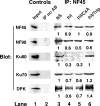Dynamic binding of Ku80, Ku70 and NF90 to the IL-2 promoter in vivo in activated T-cells
- PMID: 17389650
- PMCID: PMC1874627
- DOI: 10.1093/nar/gkm117
Dynamic binding of Ku80, Ku70 and NF90 to the IL-2 promoter in vivo in activated T-cells
Abstract
IL-2 gene expression in activated T-cells is initiated by chromatin remodeling at the IL-2 proximal promoter and conversion of a transcriptional repressor into a potent transcriptional activator. A purine-box regulator complex was purified from activated Jurkat T-cell nuclei based on sequence-specific DNA binding to the antigen receptor response element (ARRE)/nuclear factor of activated T-cells (NF-AT) target DNA sequence in the proximal IL-2 promoter. ARRE DNA-binding subunits were identified as NF90, NF45 and systemic lupus erythematosis autoantigens, Ku80 and Ku70. Monoclonal antibodies to Ku80, Ku70 and NF90 specifically inhibit constitutive and inducible ARRE DNA-binding activity in Jurkat T-cells. Ku80, Ku70 and NF90 bind specifically to the IL-2 gene promoter in vivo, as demonstrated by chromatin immunoprecipitation. Activation of Jurkat T-cells and mouse primary spleen cells induces binding of Ku80 and NF90 to the IL-2 promoter in vivo, and decreases binding of Ku70 to the IL-2 promoter in vivo, and these dynamic changes are inhibited by immunosuppressants cyclosporin A and triptolide. Dynamic changes in binding of Ku80, Ku70 and NF90 to the IL-2 proximal promoter in vivo correlate with chromatin remodeling and transcriptional initiation in activated T-cells.
Figures





Similar articles
-
CsA-sensitive purine-box transcriptional regulator in bronchial epithelial cells contains NF45, NF90, and Ku.Am J Physiol. 1998 Dec;275(6):L1164-72. doi: 10.1152/ajplung.1998.275.6.L1164. Am J Physiol. 1998. PMID: 9843854
-
NF90 regulates inducible IL-2 gene expression in T cells.J Exp Med. 2007 May 14;204(5):971-7. doi: 10.1084/jem.20052078. Epub 2007 Apr 30. J Exp Med. 2007. PMID: 17470640 Free PMC article.
-
Immunosuppressant PG490 (triptolide) inhibits T-cell interleukin-2 expression at the level of purine-box/nuclear factor of activated T-cells and NF-kappaB transcriptional activation.J Biol Chem. 1999 May 7;274(19):13443-50. doi: 10.1074/jbc.274.19.13443. J Biol Chem. 1999. PMID: 10224109
-
DNA-dependent protein kinase interacts with antigen receptor response element binding proteins NF90 and NF45.J Biol Chem. 1998 Jan 23;273(4):2136-45. doi: 10.1074/jbc.273.4.2136. J Biol Chem. 1998. PMID: 9442054
-
NF45 and NF90 regulate HS4-dependent interleukin-13 transcription in T cells.J Biol Chem. 2010 Mar 12;285(11):8256-67. doi: 10.1074/jbc.M109.041004. Epub 2010 Jan 5. J Biol Chem. 2010. PMID: 20051514 Free PMC article.
Cited by
-
Host Proteins Ku and HMGA1 As Participants of HIV-1 Transcription.Acta Naturae. 2016 Jan-Mar;8(1):34-47. Acta Naturae. 2016. PMID: 27099783 Free PMC article.
-
Transient dsDNA breaks during pre-replication complex assembly.Nucleic Acids Res. 2009 Sep;37(17):5714-24. doi: 10.1093/nar/gkp617. Epub 2009 Jul 28. Nucleic Acids Res. 2009. PMID: 19638425 Free PMC article.
-
ILF2: a multifaceted regulator in malignant tumors and its prospects as a biomarker and therapeutic target.Front Oncol. 2024 Dec 13;14:1513979. doi: 10.3389/fonc.2024.1513979. eCollection 2024. Front Oncol. 2024. PMID: 39735599 Free PMC article. Review.
-
The Polyvalent Role of NF90 in RNA Biology.Int J Mol Sci. 2022 Nov 5;23(21):13584. doi: 10.3390/ijms232113584. Int J Mol Sci. 2022. PMID: 36362366 Free PMC article. Review.
-
Differential expression and transcription factor binding associated with genotype at a pharmacogenetic variant in OPRD1.Am J Drug Alcohol Abuse. 2021 Sep 3;47(5):581-589. doi: 10.1080/00952990.2021.1954189. Epub 2021 Aug 18. Am J Drug Alcohol Abuse. 2021. PMID: 34407719 Free PMC article.
References
-
- June CH, Ledbetter JA, Lindsten T, Thompson CB. Evidence for the involvement of three distinct signals in the induction of IL-2 gene expression in human T lymphocytes. J. Immunol. 1989;143:153–161. - PubMed
-
- Mouzaki A, Rungger D. Properties of transcription factors regulating interleukin-2 gene transcription through the NFAT binding site in untreated or drug-treated naive and memory T-helper cells. Blood. 1994;84:2612–2621. - PubMed
-
- Shaw JP, Utz PJ, Durand DB, Toole JJ, Emmel EA, Crabtree GR. Identification of a putative regulator of early T cell activation genes. Science. 1988;241:202–205. - PubMed
Publication types
MeSH terms
Substances
Grants and funding
LinkOut - more resources
Full Text Sources
Other Literature Sources
Research Materials
Miscellaneous

